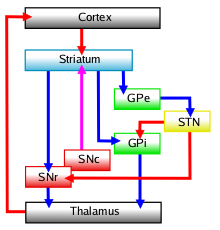External globus pallidus
| External globus pallidus | |
|---|---|
 External globus pallidus (GPe) seen in 2nd image from the left | |
| Details | |
| Part of | Globus pallidus |
| Identifiers | |
| Latin | globus pallidus externus, globus pallidus lateralis |
| Acronym(s) | GPe |
| NeuroNames | 232 |
| NeuroLex ID | birnlex_1610 |
| TA98 | A14.1.09.509 |
| TA2 | 5570 |
| FMA | 61839 |
| Anatomical terms of neuroanatomy | |
The external globus pallidus (GPe or lateral globus pallidus) combines with the internal globus pallidus (GPi) to form the globus pallidus, an anatomical subset of the basal ganglia. Globus pallidus means "pale globe" in Latin, indicating its appearance. The external globus pallidus is the segment of the globus pallidus that is relatively further (lateral) from the midline of the brain.
The GPe
The GPe is particular in comparison to the other elements of the set by the fact that it does not work as an output base of the basal ganglia (not sending axons to the thalamus) but as the main regulator of the basal ganglia system. It is sometimes used as a target for deep brain stimulation as a treatment for Parkinson's disease.
Function

Indirect pathway
The
The indirect pathway, which contains the GPe and the subthalamic nucleus, functions to modulate the effects of the direct pathway. The GPe acts as an inhibitory "control device", adjusting subthalamic nucleus neuronal activity via GABAergic output.[2]
When movement adjustment is required, striatal inhibitory GABAergic axons are sent to the GPe, decreasing inhibition of the subthalamic nucleus. The subthalamic nucleus' glutamatergic neurons then stimulate the GPi and substantia nigra pars reticulata.
This multisynaptic indirect striatopallidal pathway allows for regulated excitatory input from the subthalamic nucleus to the GPi and substantia nigra pars reticulata. This combines with direct pathway inhibition in the GPi, allowing for fine tuned basal ganglia output, and more controlled movement.
Related pathology
Lateral globus pallidus dysfunction has been observed in the following conditions:
References
